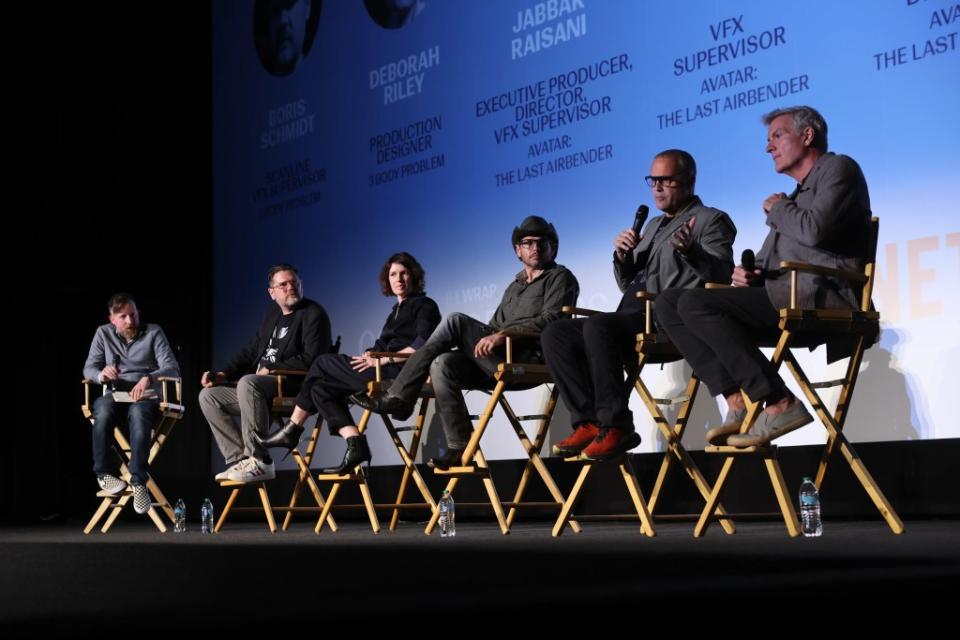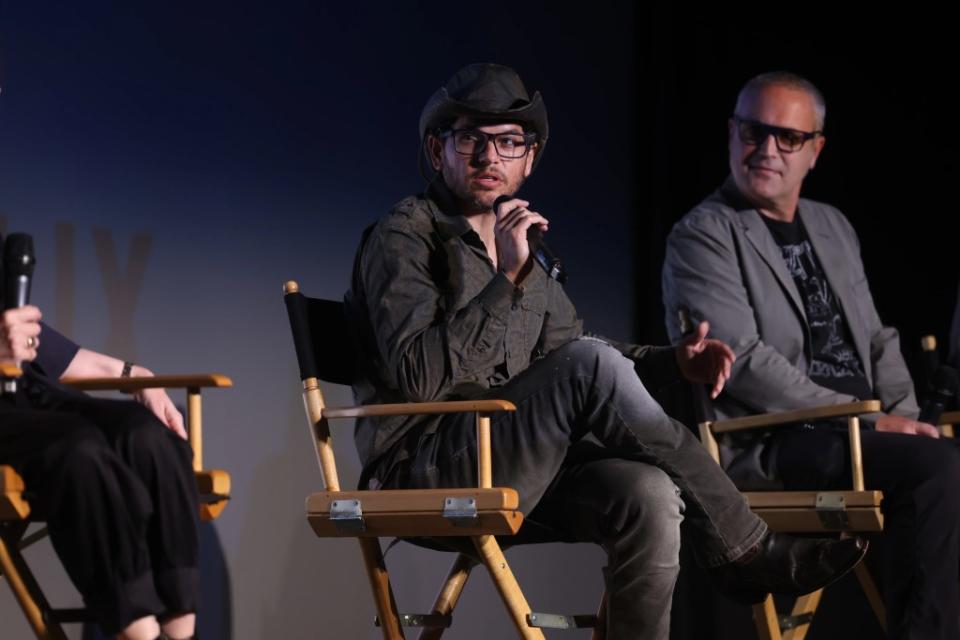‘3 Body Problem,’ ‘Avatar: The Last Airbender’ Teams Discuss the Magic of World Building
It’s no small feat to build worlds as expansive in size and scope as Netflix’s sci-fi thriller “3 Body Problem” and adventure-fantasy series “Avatar: The Last Airbender” — the former adapted from a series of Chinese novels and the latter is the live-action version of the beloved anime. The production design and VFX teams behind the two high-profile series gathered Wednesday morning for a 45-minute conversation at Los Angeles’ Harmony Gold, moderated by The Wrap’s Drew Taylor as part of our inaugural Collaborators series. Panelists included “3 Body Problem” production designer Deborah Riley and Scanline VFX supervisor Boris Schmidt, as well as “Avatar: The Last Airbender” executive producer /director/VFX supervisor Jabbar Raisani, VFX supervisor Marion Spates and production designer Michael Wylie, who came together to discuss how they brought their high-concept properties to life.
Collaboration between the production design team and the visual effects department proved vital to breeding success on “3 Body Problem,” Riley said.
“Neither of us are anything without each other — and that’s the reality of it. Production designers might start earlier concepting, getting the tone and feel of the show and then figuring out how much we build. Then our visual effects colleagues take over,” she continued. “But the epic nature of the shows we’re working on wouldn’t be what they are without the visual effects department.”
Raisani agreed, sharing that they often followed Wylie’s lead on “Avatar” in “setting the tone and look” while “working in tandem to figure out how we’re going to accomplish these things.” Wylie credited the technological advances over the past three decades in allowing the series to achieve things that “were not even possible” when he first started working in television. “They have freed us up and let us let our imaginations run completely amok — and in a really bad way,” he joked.
To bring the complex worlds of “3 Body Problem” and “Avatar” to life, the script and story are key, both teams acknowledged. “How does this design of this character’s environment embody that character?” Raisani said. “How does it take the story we’re trying to tell and elevate it and support it? It’s all in service of the story and the characters.”
Looking at storyboards and concept art also helps, Spates added. “The first time when you wrap your mind around it, you form a visual of what the shots are going to look like. I think that’s when your brain storms to form the first visual.”

Riley previously worked with “3 Body Problem” co-creators David Benioff and D.B. Weiss on “Game of Thrones” and she “quickly realized” that she wasn’t in Westeros anymore when it came time to world-building for the sci-fi series. “There was a chaotic world, a stable world, a domestic world, a cosmic kind of VR world, and we were lurching all the way from the darkest hours of the Cultural Revolution in China… into the future,” she said of “3 Body Problem.” “The concept of defining tone was [important]: What was going to hold it all together?”
The same approach she had in building out “Game of Thrones” ended up serving her on “3 Body Problem.” “The same rules I followed in Westeros applied to this one, which was making a very grounded world for all of these different scenes to take place in,” Riley said. That meant believing everything in the series as “science fact” and not science fiction, even with aliens at the heart of the story. “And that ended up being what tied it all together.”
Because “Avatar” is based on a beloved anime series, Raisani faced a different kind of pressure.
“We had a palette, but we needed to take that palette and adapt it to a live-action, grounded reality. A lot of conversations were around, how far do we take this? How saturated should this be? How much do we want it to feel like a period piece versus a fantasy piece?” he recalled. “A lot of it was tone, as well as what is the world that we’re building and what we want it to feel like?”
Because “Avatar” is an adventure show, keeping relevant cultural references while blending aspects of a fantastical world required a delicate balance.
“We wanted to take liberties in certain ways to add flair and additional design, but we wanted to remain authentic and have a palette that makes sense,” Raisani said. “So Fire Nation feels like Fire Nation, and Omashu feels like Omashu, which has a lot of South Asian influence, for example. You don’t want it to feel like everything’s a collage but you also don’t want it to feel like, ‘That’s supposed to be India.’ There was a lot of pulling from different places, but trying to be unique in our world.”
The “3 Body Problem” and “Avatar” teams detailed the laborious process of transforming massive set pieces. Wylie revealed there were approximately 15,000 sets in the first episode of “Avatar,” while Spates shared there were roughly 3,400 “hard” visual effects shots. Riley and Schmidt discussed the challenges of the fifth episode of “3 Body Problem,” which featured a heavy VFX sequence involving a ship being destroyed and hundreds of people perishing as a result.

Expect more scenes like that one, since “3 Body Problem” and “Avatar” were both renewed through Season 3 by Netflix following positive audience response.
“If something is successful that you worked on for a long time, and you put a lot of effort in and people like it, it’s very rewarding,” Schmidt said of “3 Body Problem.” Added Riley: “I remember when the trailers started coming out, I thought, ‘Well, that actually looks quite cool. I think we’re onto something.’ When the audience responded to it, it was thrilling.”
“‘Airbender’ was very stressful to release because we have this fanbase that is huge and they want the show the way they think it should be,” Raisani said, adding he was a fan of the animated series. “Let’s make the show that is the one everyone’s been hoping they were going to get, being as true as we could be to all of the animation that came before us. But we are making a different show, we have to make a different show.”
“For the show to exist, there has to be a reason and that reason is we want to make this live-action version, which has to be an adaptation,” he said. “There’s a lot of stress that goes with, ‘Oh man, we changed that. Should we have changed that? Okay, let’s see what the fans think.'”
The post ‘3 Body Problem,’ ‘Avatar: The Last Airbender’ Teams Discuss the Magic of World Building appeared first on TheWrap.

 Yahoo Movies
Yahoo Movies 
